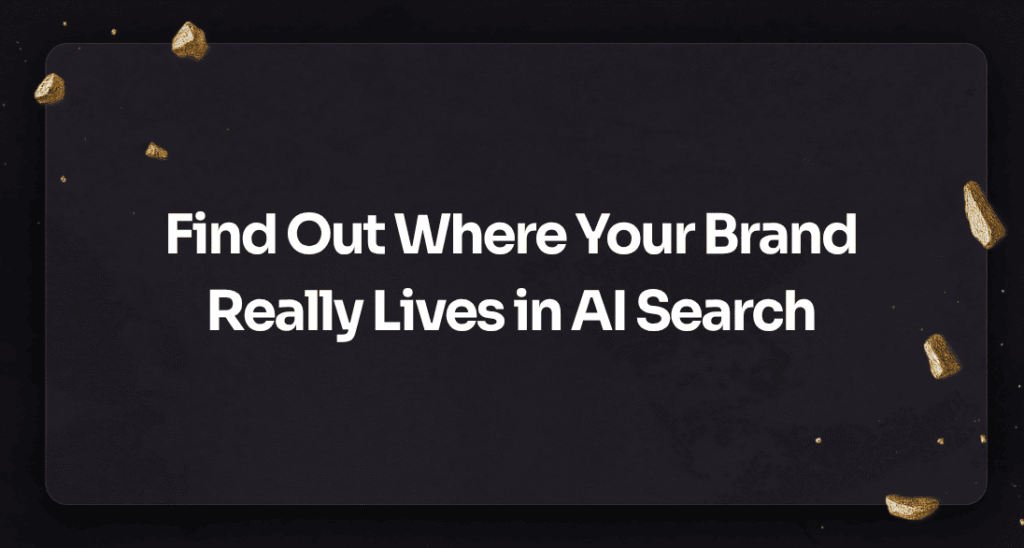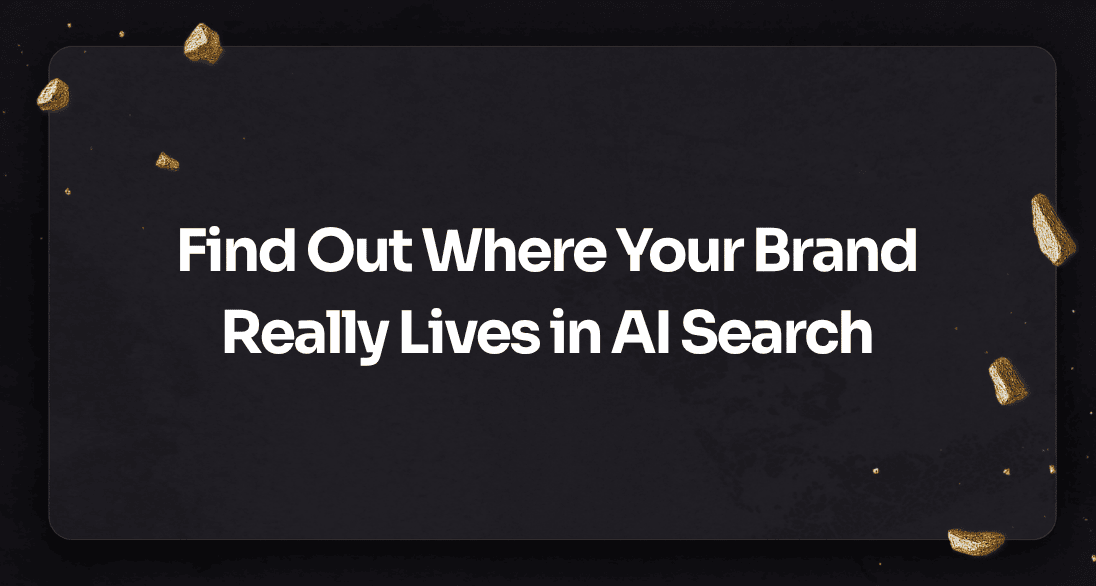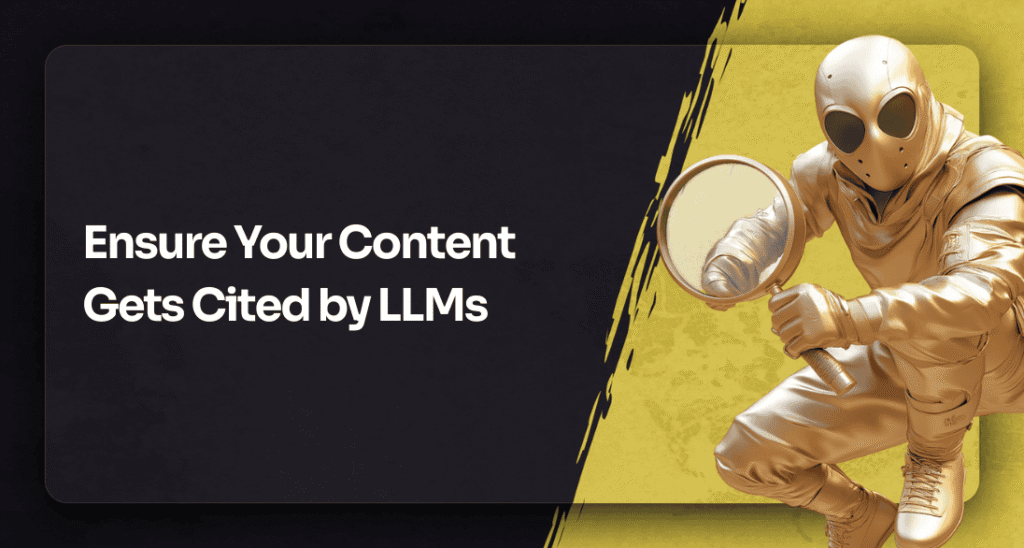Your brand can already be showing up in AI-generated answers and you might have no idea how, where, or why.
That’s because LLMs don’t just surface links. They rewrite information. They choose sources. They decide which brands get cited as trustworthy.
That decision is shaping customer perception before a click ever happens. If you’re not monitoring it, you’re letting algorithms tell your story.
We put five AI visibility tools to the test to see if they actually track, monitor, and improve how models cite your brand - or if they’re just another dashboard you’ll never use.
Key Takeaways
- AI visibility tools are now a core layer of SEO: they show how generative engines track, cite, and rank your content.
- Search behavior is shifting fast: AI answers reduce clicks but increase influence. You need to measure presence and sentiment, not just rankings.
- What we know: real-time monitoring, predictive analytics, and competitor benchmarking already give brands an edge.
- What we don’t know (yet): how each AI model weighs citations, structured data, or sentiment - but tracking tools reveal the signals.
Do you know what AI search is saying about you?
Start with an AI search optimization audit and see for yourself.
What Are AI Visibility Tools?
AI visibility tools are platforms that track, monitor, and analyze how large language models (LLMs) reference your brand, content, or products in generative search results.
Unlike traditional SEO software that focuses on backlinks, keywords, and SERPs, these tools dive into how AI engines (like ChatGPT, Claude, Gemini, or Perplexity) cite and rank your site inside their generated answers.
In practice, they’re your window into the AI engines rewriting and ranking your content.
Through that view, you can:
- Track brand presence or absence across platforms
- Analyze sentiment in AI-generated text
- Compare your visibility directly against competitors
- Identify which sources or domains AI models rely on most
Why They Matter Now
- Search behavior has shifted. Millions of queries never reach a website; they’re answered directly in AI assistants.
- Your brand might already be in the mix - or missing entirely. Without monitoring, you won’t know.
- AI visibility is measurable. Tools reveal share of voice, citation sources, and ranking signals across LLMs.
AI Visibility Tools vs. Traditional SEO Tools
| Feature | Traditional SEO Tools | AI Visibility Tools |
| Primary focus | SERP rankings, backlinks, keywords | LLM citations, brand mentions, AI-generated answers |
| Data source | Search engines (Google, Bing, etc.) | AI models (ChatGPT, Gemini, Claude, Perplexity) |
| Metrics tracked | Keywords, traffic, domain authority | Share of voice, sentiment, presence, citation accuracy |
| Goal | Improve rankings & traffic | Improve visibility in AI-generated search experiences |
AI tools don’t replace SEO software - they add a new visibility layer. You still need search rankings, but now you also need to see how algorithms summarize and present your brand in generative answers.
AI Visibility = Brand Authority
Search used to be simple: show up in Google, climb the rankings, measure the clicks. That model is breaking. AI-powered engines don’t just link to your content - they rewrite it, summarize it, and sometimes skip you altogether.
Impressions are climbing, but clicks are falling fast - down by nearly a third in the past year.
The impact is clear:
- AI answers shape perception before the click. If ChatGPT or Gemini rewrites your product page and leaves your brand name out, you lose authority before users ever visit your site.
- Traffic is no longer the only metric. Visibility now includes share of voice, citation accuracy, and how often your content is chosen over a competitor’s.
- Your competitors are already in the mix. If their content is structured for AI crawlers and yours isn’t, they’ll be cited while you disappear from answers.
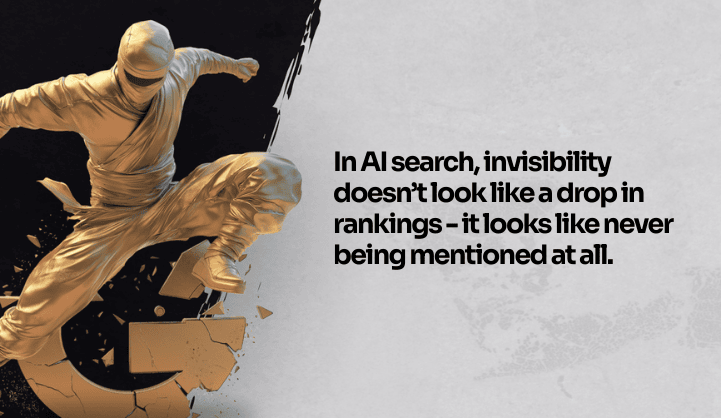
Top 5 AI Visibility Tools in 2025: Comparison Table
| Tool | Best For | Pricing Model | Standout Features | TRTM Grade |
| Otterly.ai | Marketers who want affordable AI visibility tracking tools with daily monitoring | Lite $29/mo, Standard $189/mo, Premium $489/mo (+ 14-day free trial) | Multi-engine coverage (Google AI Overviews, ChatGPT, Perplexity, MS Copilot, Gemini add-ons), scalable prompt tracking, daily visibility reports | ★★★★☆ |
| LLMhrefs | Marketing teams testing LLM optimization tools for AI visibility | $79/mo (limited time) + free start | Multi-engine tracking, competitor benchmarks, API support, cancel anytime | ★★★★☆ |
| Semrush AI SEO Toolkit | Enterprises needing comprehensive AI visibility optimization tools | $99/user/domain/mo | 300 queries per day, brand performance reports, prompt tracking across ChatGPT & Google AI | ★★★★★ |
| Ahrefs | Freelancers, agencies, and in-house SEO teams | Lite $129/mo, Standard $249/mo, Advanced $449/mo | Keyword + backlink powerhouse with tracked keywords, crawl credits, historical data, team collaboration | ★★★★☆ |
| Profound | Mid-size to enterprise brands wanting deep AI visibility and answer engine insights | Lite $499/mo (1 company, 200 prompts, 4 engines) or Enterprise custom | Tracks 10+ engines (ChatGPT, Gemini, Claude, Grok, etc.), daily prompts, agent analytics, integrations (GA, Vercel, Cloudflare), enterprise support | ★★★★★ |
Tool #1: Otterly.ai - Affordable AI Visibility Tracking with Real Coverage
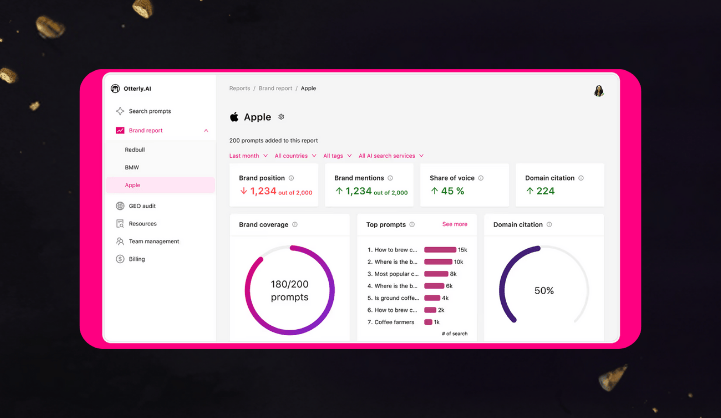
Otterly.ai positions itself as the entry point into AI visibility tools: affordable, straightforward, and designed for marketers who don’t have enterprise budgets but still need daily monitoring on multiple engines.
What It Does
- Tracks mentions and citations across Google AI Overviews, ChatGPT, Perplexity, and Microsoft Copilot.
- Gemini and Google AI Mode are available as add-ons, so you can expand coverage as AI search evolves.
- Daily tracking means you’re not waiting for a weekly crawl - you see brand visibility in near real-time.
Pricing Breakdown
- Lite ($29/mo): 15 search prompts per day - perfect for testing and small brands.
- Standard ($189/mo): 100 prompts, scalable with $99 add-ons, best for mid-size teams.
- Premium ($489/mo): 400 prompts, built for agencies or in-house SEO leads running large portfolios.
- Free 14-Day Trial: lets you actually test visibility before committing.
Strengths
- Cost-effective: Even the Lite plan gives marketers a view into AI engines for less than a night out.
- Scalable: Prompt coverage expands as you grow - and you won’t be forced into enterprise pricing too early.
- Daily visibility: No waiting for “monthly reports.”
Limitations
- Prompt caps can add up fast if you’re tracking multiple products or markets.
- More reporting than strategy: You’ll see where you stand, but the tool doesn’t coach you on next moves.
Verdict
For small to mid-size teams, Otterly.ai is the best low-cost option to test AI search visibility. It’s not a full replacement for premium analytics, but it gives you real, trackable visibility inside the AI engines rewriting how people find brands.
PRO TIP
Use Otterly’s free trial to measure your brand visibility against competitors. If you’re invisible in Perplexity or Copilot, that’s data you can’t afford to ignore.
Tool #2: LLMhrefs - Built for Marketing Teams Testing the AI Layer
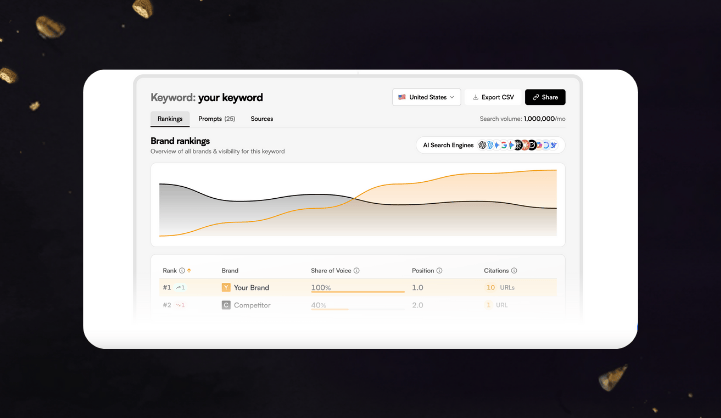
LLMhrefs takes a familiar SEO mindset (competitor tracking, performance measurement, and reporting) and applies it directly to AI visibility optimization. It’s positioned for marketing teams that need more than free experiments but aren’t ready to lock into enterprise pricing.
What It Does
- Monitors how brands show up in AI search engines and LLM outputs.
- Tracks competitor visibility side-by-side so you can see who gets cited more often and in what contexts.
- Provides API access, making it easier to plug visibility data into your own dashboards or reporting systems.
Pricing Breakdown
- $79/month → Standard subscription.
- Free start available → You can test the platform before committing.
- Cancel anytime → Month-to-month flexibility with no long contracts.
Strengths
- Accessible pricing: For less than most SEO software, you get real AI brand visibility tracking tools.
- Team-ready: Plans are structured for marketing departments, not just solo freelancers.
- Flexible: Start free, scale into paid, leave if it’s not useful - no lock-in.
Limitations
- Still developing: As a younger tool, it doesn’t have the historical datasets of Ahrefs or Semrush.
- Feature set is narrower: It covers the essentials but lacks advanced predictive modeling.
Verdict
LLMhrefs is a smart entry for marketing teams that want affordable AI visibility tracking with a competitive lens. It’s not the deepest platform yet, but at $79/month with a free start, it gives marketers a no-risk way to test the AI search layer before investing big.
PRO TIP
Use LLMhrefs to spot competitor mentions before your own. If they’re showing up in AI answers more often, that’s your roadmap to fix.
Tool #3: Semrush AI SEO Toolkit - Enterprise-Ready Power with a Price Tag
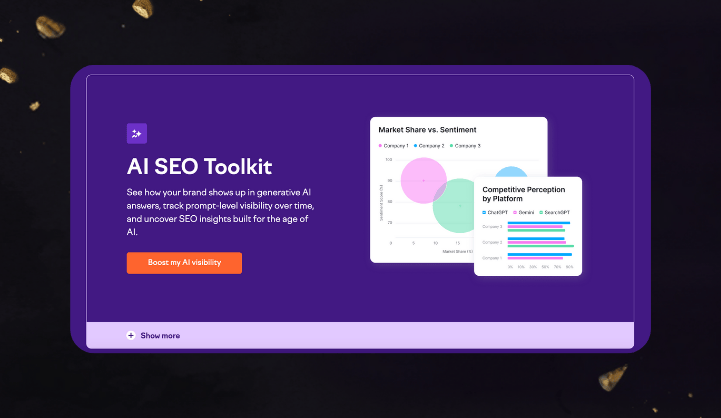
Semrush isn’t new to SEO, but its AI SEO Toolkit pushes the platform into the AI visibility category. It’s built for enterprise teams that want a single suite for traditional SEO + AI search visibility tracking.
What It Does
- Provides a Visibility Overview (up to 300 queries per day) to show how your brand appears in AI search engines.
- Generates Brand Performance Reports, tracking one domain per subscription (with add-ons available).
- Offers Prompt Tracking across ChatGPT and Google AI Mode - 10 prompts per LLM on the base plan.
Pricing Breakdown
- $99/user/domain/month
- Additional domains: $99/month each
- Includes both traditional SEO features and the new AI visibility optimization tools
Strengths
- Comprehensive: Combines AI visibility with Semrush’s proven SEO toolkit.
- Enterprise-friendly: Designed for teams managing multiple markets and domains.
- Predictive insights: Goes beyond mentions by analyzing how algorithms may treat your site next.
Limitations
- Costly for small teams: $99 per user, per domain, per month adds up quickly.
- Domain limits: Only one domain per subscription unless you pay extra.
Verdict
Semrush AI SEO Toolkit is the premium choice for companies already invested in Semrush’s ecosystem. It’s powerful, well-integrated, and reliable but the price makes it better suited for enterprise budgets than scrappy marketing teams.
PRO TIP
If you already use Semrush for keyword and backlink analysis, adding the AI SEO Toolkit consolidates visibility tracking into one platform - no need to juggle separate dashboards.
Tool #4: Ahrefs - SEO Giant Extending Into AI Visibility
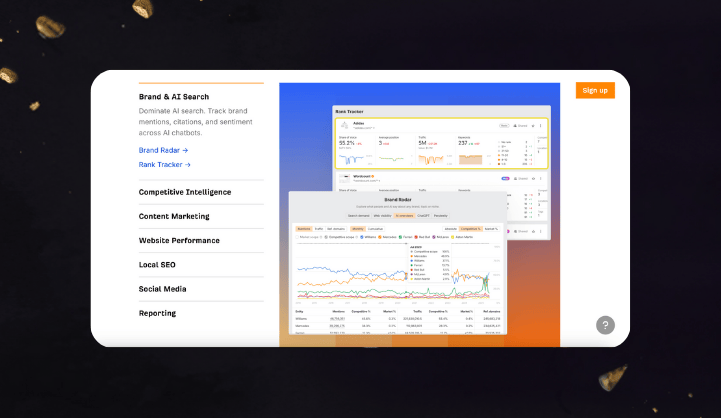
Ahrefs has long been a cornerstone SEO platform - known for backlink analysis, keyword tracking, and competitive research. Now, it’s layering AI search visibility tools into its suite, making it a strong option for teams that want both traditional SEO depth and a growing focus on AI.
What It Does
- Tracks thousands of keywords while monitoring how they appear in both search engines and AI-driven answers.
- Provides robust site audits and crawler insights, showing how algorithms read your pages.
- Expands reporting with historical datasets (up to 5 years) to spot trends over time.
Pricing Breakdown
- Lite ($129/mo): 5 projects, 6 months of data history, 750 tracked keywords.
- Standard ($249/mo): 20 projects, 2 years of data, 2,000 tracked keywords.
- Advanced ($449/mo): 50 projects, 5 years of data, 5,000 tracked keywords.
- All plans include crawl credits, user options, and scalable team add-ons.
Strengths
- Data-rich: No one matches Ahrefs for sheer depth of backlink and keyword tracking.
- Reliable audits: The crawler is among the best in the industry.
- Scalable: Plans fit freelancers up to large in-house teams.
Limitations
- Price: More expensive than entry-level AI visibility tools.
- AI features are newer: Still building depth compared to platforms built AI-first.
Verdict
Ahrefs is the best choice for teams that want an SEO powerhouse with growing AI visibility features baked in. It’s not the cheapest, but its depth of data and proven infrastructure make it a safe bet for scaling teams.
PRO TIP
If you already rely on Ahrefs for link building and keyword visibility, its AI reporting layers in seamlessly, giving you a single source of truth for both SEO and AI search visibility.
Tool #5: Profound - Deep AI Visibility for Enterprise Teams
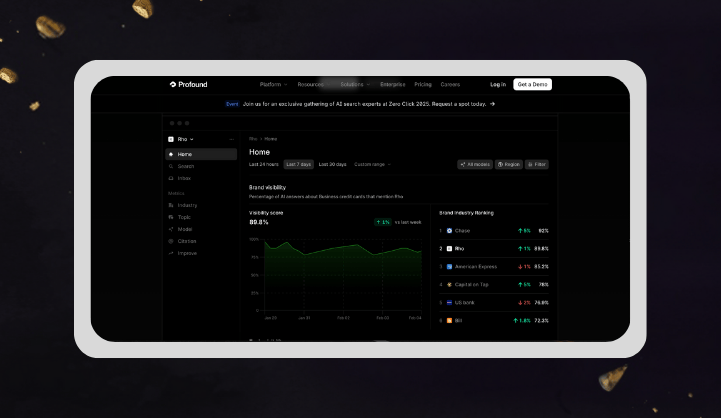
Profound is designed for brands and agencies managing multiple products, markets, and languages that need more than surface-level tracking. If Otterly and LLMhrefs are for getting started, Profound is for scaling visibility into a full enterprise strategy.
What It Does
- Tracks mentions and brand performance in 10+ AI engines, including ChatGPT, Google AI Overviews, Gemini, Claude, Perplexity, Copilot, Meta AI, and more.
- Provides Agent Analytics to connect AI-sourced visibility with actual site traffic and attribution.
- Offers workflow features like content briefs, optimization recommendations, and opportunity spotting based on prompt analysis.
- Integrates with Google Analytics, Vercel, Cloudflare, AWS, Netlify, and Fastly for seamless reporting.
Pricing Breakdown
- Lite ($499/mo): 1 company, 200 prompts, 4 engines, 1 month of data history.
- Enterprise (custom): Multiple companies, unlimited prompts, all engines, full history, API access, SSO + SOC2 compliance, dedicated strategist, and Slack support.
Strengths
- Depth: Tracks more engines and prompts than any other tool on this list.
- Enterprise features: SSO, SOC2 compliance, API access, dedicated strategist.
- All-in-one reporting: Covers both visibility insights and content optimization workflows.
Limitations
- Price: Starting at $499/month, it’s not realistic for smaller teams.
- Learning curve: With more features comes more complexity.
Verdict
Profound is the most comprehensive AI visibility optimization tool for enterprises. It’s expensive, but if your brand spans multiple markets or products, the breadth of tracking and enterprise-level support make it worth the investment.
PRO TIP
Profound’s biggest value is connecting AI mentions to real business impact. If you’re running global campaigns, this link between visibility and attribution is where budgets get defended.
Key Features to Look For in AI Visibility Tools
Not all AI visibility tools deliver the same value. Some give you raw data, others layer in predictive analytics, and only a few combine both into actionable, real-time insights. If you’re evaluating options, here are the features that separate the best AI visibility tools for SEO from the rest:
1. Real-Time Monitoring
AI engines update constantly. You need a tool that can track citations, mentions, and visibility shifts as they happen - not in a monthly report.
2. Multi-Engine Tracking
Google isn’t the only game anymore. The most effective AI brand visibility tracking tools scan ChatGPT, Gemini, Claude, Perplexity, and even industry-specific models. The wider the coverage, the clearer your visibility map.
3. Sentiment & Accuracy Analysis
It’s not enough to know if you’re mentioned - you need to know how you’re represented. Advanced tools use AI visibility optimization features to detect tone, sentiment, and accuracy in generated answers.
4. Predictive Ranking Models
Some platforms now offer LLM optimization tools for AI visibility, simulating how your site might appear in generative results tomorrow based on today’s patterns.
5. Customizable Dashboards
The best tools for tracking brand visibility in AI search platforms don’t lock you into canned reports. They let you build customizable dashboards around the metrics that matter: citations, competitor benchmarks, traffic correlation, or share of voice.
6. Integration with SEO Analytics
Standalone data is limited. Choose AI search visibility tools with SaaS cloud integrations that connect with Google Analytics, Search Console, or your existing SEO stack. A GEO audit can reveal if those integrations are already picking up your brand mentions inside AI search.
How AI Visibility Tools Improve SEO
Traditional SEO was about rankings and clicks. AI visibility is about recognition and authority. The two are linked, but they don’t play by the same rules.
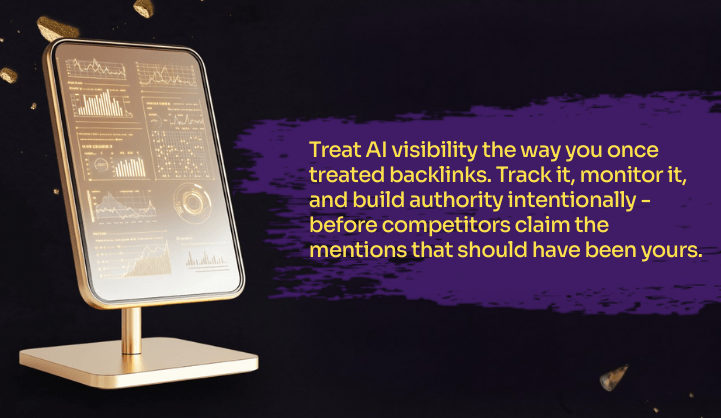
From Rankings → Recognition
Search engines used to reward position: #1, #2, #3. Now, AI-driven platforms reward recognition: which brands are named, cited, or summarized in answers.
AI search visibility tools measure this presence and show you whether your content is influencing the results that users see.
Sentiment and Authority Signals
AI visibility optimization tools track sentiment (whether your brand is presented positively, neutrally, or negatively) and authority signals, such as whether your site or a third-party source is being cited. These are the cues LLMs use to decide if you’re credible.
New Metrics to Monitor
Here’s where AI brand visibility tracking tools stand apart from traditional SEO software:
- Citations: how often your content or domain appears in AI-generated answers.
- Accuracy: whether the AI is quoting your information correctly.
- Share of Voice: how your visibility compares to competitors inside AI platforms.
- Prompt Coverage: which types of questions surface your brand - and which don’t.
Together, these metrics paint a more complete picture of how your brand lives (or doesn’t) in generative results.
Choosing the Right Tool for Your Business
Not every team needs an enterprise platform on day one. The smart move is to match your AI visibility tools to your budget, team size, and immediate goals.
Free and Freemium Options
- Otterly.ai - Ideal entry point with a 14-day free trial. Gives you daily monitoring on ChatGPT, Perplexity, Google AI Overviews, and Copilot.
- LLMhrefs - Built with SEO pros in mind. Affordable plans plus a free start option. Great for marketers who want competitive insight before investing in larger platforms.
Premium Platforms for Scale
- Semrush AI SEO Toolkit - At $99/month per domain, it combines traditional SEO with AI search visibility reporting. Strong integrations, but better suited for teams already managing multiple markets.
- Ahrefs - Advanced SEO analytics expanded into AI tracking. Starts at $129/month, making it useful for consultants and in-house teams needing both link/data depth and AI insights.
- Profound - Enterprise-ready, starting at $499/month. Tracks multiple engines (ChatGPT, Gemini, Copilot, Perplexity, more) with customizable prompts, sentiment analysis, and global reporting.
Guidance by Team Size and Goals
- Solo marketer / small business: Start with Otterly or LLMhrefs. Get baseline data. Learn how you’re represented in AI answers.
- Mid-size marketing teams: Layer in Semrush or Ahrefs. Blend traditional SEO + AI visibility tracking in one dashboard.
- Enterprise / global brands: Go with Profound. You’ll need scalability, compliance, and cross-market monitoring.
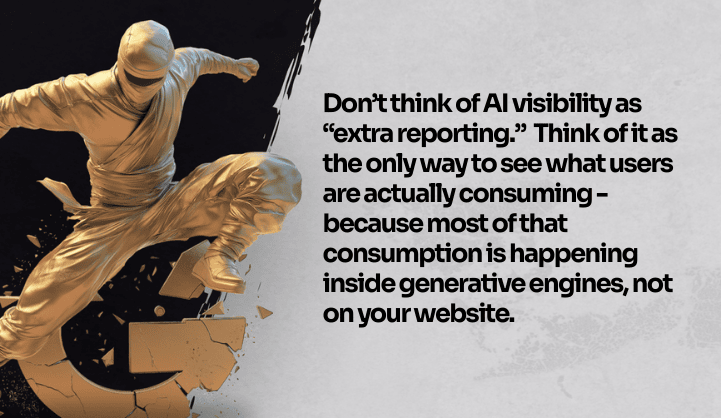
What to Check Before You Commit
✔ Engines covered - Does the tool track ChatGPT, Gemini, Perplexity, Copilot, or just one?
✔ Prompt capacity - How many queries per day/month are included, and can you scale affordably?
✔ Reporting frequency - Daily snapshots or real-time monitoring?
✔ Metrics tracked - Mentions, citations, sentiment, accuracy, share of voice.
✔ Integrations - Can it sync with Google Analytics, Data Studio, or your SEO dashboards?
✔ Data history - How far back can you analyze trends (weeks, months, years)?
✔ Pricing transparency - Clear plans vs. hidden enterprise quotes.
✔ Team access - Does it support multiple users, regions, or languages?
Are AI Tools the Real Thing or Just a Trend?
AI visibility platforms are not a passing experiment. They’re becoming the operating layer for how brands get recognized in search results powered by large language models.
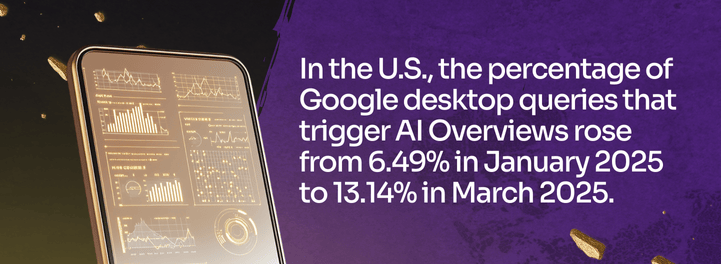
Here’s the difference:
- Trends are reactive. They chase hype cycles.
- Real tools deliver consistent, measurable impact. They show you where your brand appears, how it’s represented, and what to fix when it doesn’t.
At The Real Thing Marketing, we care about the second category. Reliable performance. Transparent data.
That’s why our stance is simple: If you’re not tracking how AI engines describe your brand, someone else is - and they’re controlling the narrative.
Wondering if your brand is even visible in AI search?
Our digital marketing services include AI visibility audits to give you the answer.
Wrap Up
Every day, engines like ChatGPT, Gemini, and Perplexity decide which brands get surfaced and which get skipped. That decision is already influencing how people discover, evaluate, and trust companies.
The tools we tested (from entry-level Otterly.ai to enterprise-ready Profound) can expose blind spots: the prompts where you don’t appear, the platforms that misstate your brand, the moments where competitors dominate.
That’s the real value: not dashboards for the sake of dashboards, but a clearer picture of where your brand lives inside AI-generated results - and whether that presence earns trust or erodes it.
Frequently Asked Questions
What are AI visibility tools?
They’re platforms that track how often your brand appears in generative search engines like ChatGPT, Gemini, and Perplexity - and whether that visibility is accurate, positive, or missing altogether.
Which AI visibility tools are best in 2025?
Otterly.ai and LLMhrefs work well for small teams. Semrush and Ahrefs give broader SEO + AI tracking. Profound is built for enterprise-scale monitoring.
How do AI visibility tools work?
They query AI engines daily, log when your brand is mentioned, and report on accuracy, sentiment, and share of voice compared to competitors.
Can AI tools improve my SEO rankings?
Indirectly. They don’t boost rankings on their own, but they show you gaps and misrepresentations that can guide SEO, content, and digital marketing strategy.
Are AI SEO tools worth it?
Yes. Traditional SEO tools measure clicks and rankings. AI visibility tools measure recognition inside generative results - a layer that now influences user decisions before they reach your site.
What should I look for in an AI visibility platform?
Check engines covered, prompt capacity, reporting frequency, integrations, and cost. Match tool scope to your team size and goals.
How much do AI visibility tools cost?
Pricing runs from $29/month (Otterly.ai) to $499+/month (Profound). Semrush and Ahrefs sit in the mid-range, popular with agencies.
What are the benefits for e-commerce brands?
They ensure product pages appear correctly in AI-driven shopping results and catch errors or missing mentions that can cost conversions.
How customizable are AI visibility dashboards?
Entry-level tools keep reporting simple. Enterprise platforms like Profound offer customizable dashboards, exports, and analytics integrations.

